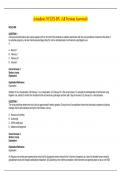Exam (elaborations)
Actualtests NCLEX-RN. (All Versions Answered)
- Course
- Institution
Actualtests NCLEX-RN. (All Versions Answered)-A 25-year-old client believes she may be pregnant with her first child. She schedules an obstetric examination with the nurse practitioner to determine the status of her possible pregnancy. Her last menstrual period began May 20, and her estimated date ...
[Show more]



